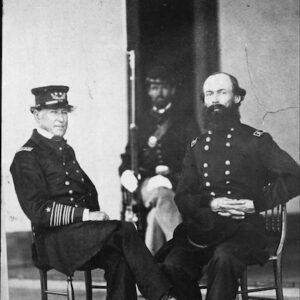Tag: 3rd US Cavalry
Wikipedia says: The 3rd Cavalry Regiment, formerly 3rd Armored Cavalry Regiment (“Brave Rifles”) is a regiment of the United States Army currently stationed at Fort Hood, Texas.
The regiment has a history in the United States Army that dates back to 19 May 1846, when it was constituted in the Regular Army as the Regiment of Mounted Riflemen at Jefferson Barracks, Missouri. This unit was reorganized at the start of the American Civil War as the 3rd U.S. Cavalry Regiment on 3 August 1861.
…In April 1861, the American Civil War broke out and 13 officers left the regiment to join the cause of the Confederacy, including future generals Joseph “Fighting Joe” Wheeler, William W. Loring, Dabney H. Maury, William H. Jackson, George B. Crittenden, and John G. Walker. Not a single enlisted man left the regiment.
At the outbreak of the war, a Confederate force of about 3,000 Texans began a campaign at Fort Bliss, Texas to seize the territories of New Mexico and Colorado. The Regiment of Mounted Riflemen was one of the few Regular Army units in the region available to oppose them. On 25 July 1861, detachments of Companies B and F were involved in a hard fight at Mesilla under MAJ Isaac Lynde. Here, they charged the Confederate lines but were driven back after the attack faltered from accurate return fire, and the men retired to Fort Fillmore, where it was later surrendered on 26 July.
Prior to the Civil War, the US Army fielded five mounted regiments; the 1st Dragoons, 2nd Dragoons, the Regiment of Mounted Riflemen, the 1st Cavalry, and the 2nd Cavalry. On 3 August 1861, all mounted regiments of the U.S. Army were classified as “cavalry”, and the Regiment of Mounted Riflemen was re-numbered the 3rd U.S. Cavalry Regiment, headquartered at Fort Thomas, third in precedence in the Regular Army.
Due to attrition, the regiment dwindled in size, and the troopers from Companies A, B, and H were transferred to other commands, leaving the 3rd Cavalry Regiment no larger than a battalion. Regardless, Companies C, G, and K defeated a Rebel cavalry unit near Fort Thorn, New Mexico on 26 September 1861. On 21 February 1862, Companies C, D, G, I, and K under MAJ Thomas Duncan fought in the Battle of Valverde, the largest land battle of the Civil War west of the Mississippi River. The battle occurred at a strategically important ford across the Rio Grande north of Fort Craig, New Mexico. The Union forces, under General Edward Canby, attempted to hold off the Confederates under General Henry Hopkins Sibley but were outflanked. During the fighting, an officer from E Company, 3rd Cavalry, CPT Alexander McRae, commanded a battery of artillery and inflicted heavy damage upon the attacking enemy, but were eventually charged and destroyed. CPT McRae was from North Carolina, and was ostracized by his family for continuing to fight for the Union. During the battle, he and his provisional battery held off several waves of Confederate attacks util they were overrun. McRae was killed in the fighting, and Fort McRae, New Mexico was named in his honor. He was one of two officers of the 3rd Cavalry Regiment killed in action in the Civil War.
After the Battle of Valverde, Companies C and K engaged in a fight with the Indians at Comanche Canyon while Company E was assisting with the evacuation of Albuquerque and Santa Fe through 4 March. On 26 March 1862, Company C was engaged at Apache Canyon by Confederate forces, this proved to be the opening skirmish of the Battle of Glorieta Pass. During this battle, the 3rd Cavalry troopers and other Union forces defeated the Confederates, and a unit of Colorado volunteers destroyed the enemy supply train, forcing them to abandon all ambitions of taking New Mexico or Colorado. As the Confederate forces retreated back to Texas, they were pursued by the 3rd Cavalry, who caught up with them at Peralta. During this battle, Companies D, E, G, I, and K skirmished with the enemy and forced them to retreat, ending the New Mexico Campaign. E Company pursued the retreating Confederates all the way back to Texas until 22 April. Following this action, the regiment traveled to Jefferson Barracks on 23 November, then to Union occupied Memphis, Tennessee in December, where it remained until October 1863.
Between October and December 1863, the 3rd Cavalry participated in operations on the Memphis and Charleston Railroad and fought in skirmishes at various locations such as Barton Station, Cane Creek, and Dickinson’s Station, Alabama. It was then tasked by General William T. Sherman to perform various reconnaissance missions as part of his army’s advance guard. During the Knoxville Campaign, the regiment scouted and screened the advance of the relief expedition. Elements of the regiment also skirmished with Confederate units at Murphy, North Carolina and Loudon, Tennessee.
From May 1864 until the end of the war, the 3rd Cavalry Regiment was stationed in Little Rock, Arkansas. Their duties included “preventing the organization of enemy commands, capturing guerrilla bands and escorting trains.” During one patrol from Little Rock to Benton, Arkansas on 21 August 1864, the troopers were ambushed by Confederate guerrillas and forced to flee. The resulting confusion and rapid escape came to be known as the “Benton Races.” When the Civil War ended, the 3rd Cavalry remained in Little Rock until April 1866 during the Reconstruction Era. They had lost two officers and thirty enlisted men who were either killed in action or died of wounds and three officers and 105 enlisted men who died of disease or other non-combat causes.
Showing the single result
